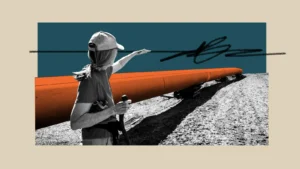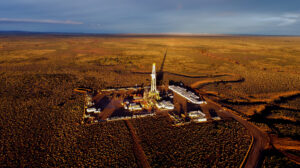What Drilling Has Wrought in Louisiana
The petrochemical industry's lust for resources has opened the jaws of hell near the town of Bayou Corne, La., where 350 residents were evacuated one year ago to escape being either swallowed or blown up, Tim Murphy of Mother Jones reports.
The petrochemical industry’s lust for resources has opened the jaws of hell near the town of Bayou Corne, La., where 350 residents were evacuated one year ago to escape being either swallowed or blown up, Tim Murphy of Mother Jones reports.
The extraction operation, directed by a company called Texas Brine, sits on top of a three-mile-wide, mile-plus-deep salt deposit covered by a layer of oil and natural gas. The company performed what is known as injection mining, in which it “sunk a series of wells deep into the salt dome, flushing them out with high-pressure streams of freshwater and pumping the resulting saltwater to the surface.” From there, the brine is extracted and carried to refineries along the Mississippi River for use in the manufacture of such diverse items as paper and medical products.
“What happened in Bayou Corne, as near as anyone can tell,” Murphy writes, “is that one of the salt caverns Texas Brine hollowed out—a mine dubbed Oxy3—collapsed. The sinkhole initially spanned about an acre. Today it covers more than 24 acres and is an estimated 750 feet deep. It subsists on a diet of swamp life and cypress trees, which it occasionally swallows whole. It celebrated its first birthday recently, and like most one-year-olds, it is both growing and prone to uncontrollable burps, in which a noxious brew of crude oil and rotten debris bubbles to the surface. But the biggest danger is invisible; the collapse unlocked tens of millions of cubic feet of explosive gases, which have seeped into the aquifer and wafted up to the community. The town blames the regulators. The regulators blame Texas Brine. Texas Brine blames some other company, or maybe the regulators, or maybe just God.”
What Texas Brine unleashed is the “biggest ongoing industrial disaster in the United States you haven’t heard of.” It has revealed the fact that modern industrial mining is tinkering with the geological order in ways that scientists don’t appear yet to fully understand. In addition to sinkholes and gas leaks, the drilling practice known as fracking has been linked to an increased risk of earthquakes.
“When you keep drilling over and over and over again, whether it’s into bedrock or into salt caverns, at some point you have fractured the integrity of this underground structure enough that something is in danger of collapsing,” observes ecologist and author Sandra Steingraber, whose work has focused on fracking and injection wells. “It’s an inherently dangerous situation.”
Louisiana has filed a lawsuit against the company and the principal landowner, Occidental Chemical Corporation, for damages resulting from the cavern collapse.
— Posted by Alexander Reed Kelly.
Your support matters…Independent journalism is under threat and overshadowed by heavily funded mainstream media.
You can help level the playing field. Become a member.
Your tax-deductible contribution keeps us digging beneath the headlines to give you thought-provoking, investigative reporting and analysis that unearths what's really happening- without compromise.
Give today to support our courageous, independent journalists.






You need to be a supporter to comment.
There are currently no responses to this article.
Be the first to respond.